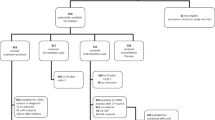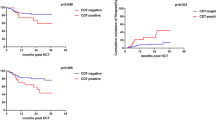Abstracts
The proportion of CD34 + CD38 − CD123 + leukemia stem cells (LSCs) at diagnosis of Acute Myeloid Leukemia (AML) correlated with induction remission (IR), relapse free survival and overall survival in few studies. Prospectively bone marrows of AML patients were immunophenotyped for CD34 + CD38 − CD123 + LSCs at baseline using sequential gating, relevant clinical and laboratory data collected and clinical outcomes were studied.The patients (n = 47) were risk stratified as favorable risk, intermediate risk and adverse risk. The percent of LSCs at baseline in favorable risk group (mean = 13.06%) was significantly less than the adverse (mean = 34.8%, p = 0.027) and the intermediate risk group (mean = 53.2%, p = 0.001). On further analysis, 12 patients attaining IR in intermediate risk group had significantly less LSCs than 15 in non-IR group (mean = 21.18%; range 3–85.6% vs mean = 73.85%; range 12.1–97.9%, p = 0.0002). Of all 47 patients, the proportion of LSCs at baseline was significantly less in those achieving IR (p = 0.024) and correlated with time to response (TTR) (rs = 0.432). Thus to conclude, the proportion of CD34 + CD38 − CD123 + LSCs at diagnosis is less in the favorable than the intermediate and adverse risk groups and is an emerging novel marker for predicting remission in the prognostically diverse intermediate risk group.


Similar content being viewed by others
Data Availability
The data published in this study is original to the author and the raw data is available with the first author as she is the primary author of this study.
References
Döhner H, Estey E, Grimwade D et al (2017) Diagnosis and management of AML in adults: 2017 ELN recommendations from an international expert panel. Blood 129(4):424–447
Bonnet D, Dick JE (1997) Human acute myeloid leukemia is organized as a hierarchy that originates from a primitive hematopoietic cell. Nat Med 3:730–737
Vergez F, Green AS, Tamburini J et al (2011) High levels of CD34+ CD38low/−CD123+blasts are predictive of an adverse outcome in acute myeloid leukemia: a GroupeOuest-Est des LeucemiesAigues et Maladies du Sang (GOELAMS) study. Haematologica 96:1792–1798
Ishikawa F, Yoshida S, Saito Y et al (2007) Chemotherapy resistant human AML stem cells home to and engraft within the bone marrow endosteal region. Nat Biotechnol 25(11):1315–1321
Al-Mawali A (2013) Leukemic stem cells shows the way for novel target of acute myeloid leukemia therapy. J Stem Cell Res Ther. 3:151. https://doi.org/10.4172/2157-7633.1000151
Zahran AM, Aly SS, Rayan A et al (2018) Survival outcomes of CD34+CD38−LSCs and their expression of CD123 in adult AML patients. Oncotarget 9(75):34056–34065
Hwang K, Park CJ, Jang S et al (2012) Flow cytometric quantification and immunophenotyping of leukemic stem cells in acute myeloid leukemia. Ann Hematol 91:1541–1546
Plesa A, Elhamri M, Clapisson G et al (2015) Higher percentage of CD34+CD38-cells detected by multiparameter flow cytometry from leukapheresis products predicts unsustained complete remission in acute myeloid leukemia. Leuk Lymphoma 56:622–629
Han L, Jorgensen JL, Wang SA et al (2013) Leukemia stem cell marker CD123 (IL-3R alpha) predicts minimal residual disease and relapse, providing a valid target For SL-101 in acute myeloid leukemia with FLT3-ITD mutations. Blood 122:359
Jin L, Lee EM, Ramshaw HS et al (2009) Monoclonal antibody-mediated targeting of CD123, IL-3 receptor alpha chain, eliminates human acute myeloid leukemia stem cells. Cell Stem Cell 5:31–42
Author information
Authors and Affiliations
Corresponding author
Ethics declarations
Conflicts of interest
The authors declare that they have no competing interest.
Ethics
The study was approved by the Institute Ethics Committee (IEC).
Consent for Publication
All the authors consent to publish the article in Indexed journal. The article has not been sent to any other journal for publication at the same time.
Additional information
Publisher's Note
Springer Nature remains neutral with regard to jurisdictional claims in published maps and institutional affiliations.
Rights and permissions
About this article
Cite this article
Mishra, P., Tyagi, S., Sharma, R. et al. Proportion of CD34+CD38−CD123+ Leukemia Stem Cells at Diagnosis Varies in ELN Risk Groups and an Emerging Novel Marker for Prognosticating the Intermediate Risk patients of Acute Myeloid Leukemia: A Prospective Study. Indian J Hematol Blood Transfus 37, 391–397 (2021). https://doi.org/10.1007/s12288-020-01383-9
Received:
Accepted:
Published:
Issue Date:
DOI: https://doi.org/10.1007/s12288-020-01383-9




